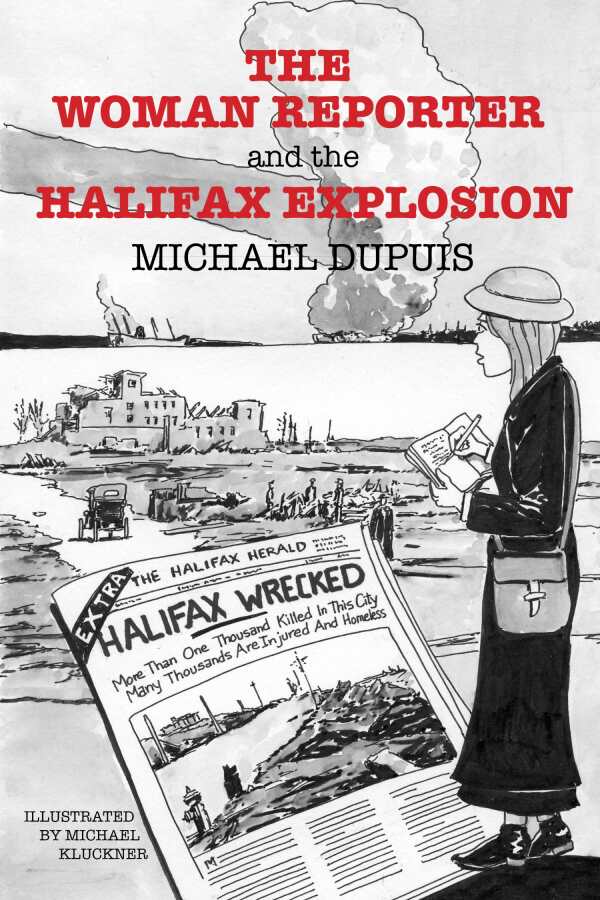The Woman Reporter and the Halifax Explosion
An intrepid, boundary-breaking reporter investigates a terrible maritime collision in the riveting historical novel The Woman Reporter and the Halifax Explosion.
In Michael Dupuis’s historical novel The Woman Reporter and the Halifax Explosion, a journalist follows the story of Canada’s 1917 Halifax tragedy.
A cub reporter for the Toronto Advocate, twenty-three-year-old Kate worked her way up from a stenographer position. When her editor receives a dispatch about a devastating accident between two large ships in Halifax, he makes the progressive decision to send Kate to cover the story’s “human-interest” angle. Kate attended college in Halifax and is familiar with the city; eager to prove herself, she accepts the assignment and hurries to catch the next Maritime Express train.
At the ruins of the disaster, she sees shattered windows, cratered buildings, ruptured water pipes, and toppled trees. She speaks with survivors and visits the emergency morgue set up in a school building, where the “weary and desperate” search for loved ones through piles of “mangled and blackened corpses.” Overwhelmed hospitals attend to the burned and wounded; many require the surgical removal of their eyes due to injuries from glass shards and other propelled debris.
Moving beyond her editor’s requested human-interest story, Kate later investigates the possibility of a rigged investigation of the disaster, as the ships’ surviving crew members are questioned during the official Wreck Commission Inquiry. She notes era prejudices against Germans due to Canada’s involvement in World War I, along with longstanding anti-French sentiment and tensions between Anglo-Canadians and Quebecois. As another wartime consequence, Kate’s reportage is subject to government censorship; violations could lead to monetary fines, suspension of journalistic credentials, or imprisonment.
Kate is an intrepid heroine who maintains a sense of focused compassion throughout. Upon tripping over a group of coffins being readied for victims, she says a quiet prayer for the dead. She ignores baiting comments from other reporters who say that she should be back in Toronto covering the Advocate‘s “Women’s Page.” Though she avoids unethical journalistic methods, she is not overly virtuous, though.
The book’s chapters are compact and its details are reportorial, giving the book itself the flavor of a serial. Kate’s editor sports “wire-rimmed spectacles” and a “snowy Old Testament beard”; she and her colleagues pursue “scoops” and wire stories to their newspapers via hectic telegraph offices. And while the nightmarish trauma of the actual Halifax explosion is depicted with minimal pathos—instead, the book focuses on facts, as with notes that the French freighter SS Mont-Blanc carried “3,000 tons of TNT, picric acid, gun cotton and benzol” when it was hit by a Belgian “relief ship,” the Imo, and that resultant explosion caused some two thousand deaths and thousands more injuries—there are instances of personal melodrama in Kate’s life to humanize the story, as with her landlady’s sudden heart ailments and the menacing Canadian military agent who follows her throughout the city. Quirky black-and-white drawings are used to further illustrate Kate’s various interactions.
In the historical novel The Woman Reporter and the Halifax Explosion, a determined heroine brings a new vantage point to one of Canada’s worst disasters.
Reviewed by
Meg Nola
Disclosure: This article is not an endorsement, but a review. The publisher of this book provided free copies of the book and paid a small fee to have their book reviewed by a professional reviewer. Foreword Reviews and Clarion Reviews make no guarantee that the publisher will receive a positive review. Foreword Magazine, Inc. is disclosing this in accordance with the Federal Trade Commission’s 16 CFR, Part 255.

